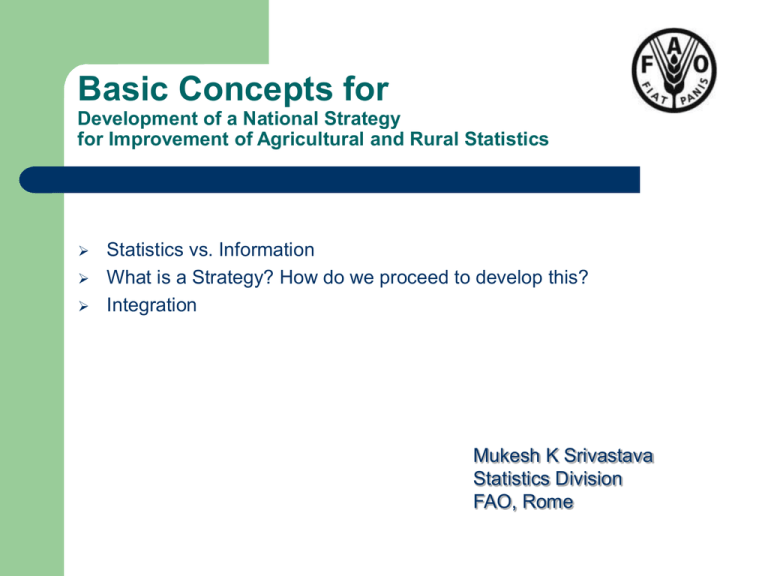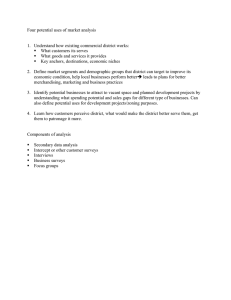Basic Concepts for
advertisement

Basic Concepts for Development of a National Strategy for Improvement of Agricultural and Rural Statistics Statistics vs. Information What is a Strategy? How do we proceed to develop this? Integration Mukesh K Srivastava Statistics Division FAO, Rome Challenges of a Statistician • Key persons do not understand the importance of Statistics • Demand is always more than the available resources can provide – human resources – financial resources • Administrative processes or interested agencies continue to produce “some numbers” which are used as statistics for lack of an alternative. – lack of coordination between agencies. – turf protection Statistics or information • Is a Rapid Report on the persons affected by a natural calamity an statistics? – Level of Confidence/ Credibility – It is necessary to get this information rapidly even though it may be somewhat less reliable than that will be available from a door to survey. • Administrative Reports: coming out of established systems (relevant for only short time but is needed urgently for quick intervention) – Crop Area sown – Crop condition • Statistics from administrative sources – Export/ Import – Migration • Historical Statistical Series: Census and Surveys – Many users different levels of tolerance of credibility The Statistics come with A Seal of Quality (confidence) Well established calendar (expectation) Neutral Source (unbiased) Distinguish • Official Statistics – multi-purpose – reliable, unbiased, produced by neutral agency • Monitoring reports – special purpose – Limited to project areas • Forecasts – based on assumptions, – available information • Assessments Statistical methods can improve the quality of information generation. ¿What is a National Strategy? It is a road map for development to achieve certain Goals Optimum: with in the constraints of budget and human resources Feasible: not ideal Flexible: could accelerate or decelerate inmplementation without changing the direction It tell us: For whom to produce?: priority clients Who does what? Priority needs of the country How to do it?: sound methodology, best use of resources A plan of action follows from the Strategy Steps to develop a strategic vision The Goals The problems (Challenges) – Identification: real vs. imaginary – Define precisely the issues to be focused Analysis of present situation – – – – Strengths, Weaknesses, Opportunities and Threats Brain Storming involving all stake holders, without prejudice Search for solutions (options) Evaluations of options from different angles – (users, interest groups, donors, government, public, implementers ...) Develop a shared National Vision Strategy: a vision to follow for long term (10-15 years) – – – – From where to begin? What road to follow? Consider scenarios (most favorable and the worst) Flexibility: preparatory action for risks Planning: for both scenarios (5 year) – Long term and short term – Concrete objectives and resources Implementation: on the basis of available resources – year by year Revision of Plans: according to changes in priority, maintaining the strategy (ex. high way, livestock) ¿What is an Integrated System? A set of similar objects Savings of efforts and resource Move together in synergy and efficiently And this one? Integration of Statistics • ¿Why? – Cost-efective production and avoidance of duplication of efforts – Coherent Statistics – Greater Scope of Analysis • ¿How? – Shared cartographic material, classification, standards, concepts, definitions…. – Planinning of all the surveys in an integrated manner: A national calender of surveys – Integrated Samping design for all the surveys in the calender. ¿Does there exist a ready made product? The design is developed as per: - the national requirements and - the available resources More benefits • Flexibility differnt agencies can implement the module in which they are interested, at differnt times, in differnt zones of their choice, according to avaialbility of resources, Leave the door open for more survey modules to be added to the plan based upon already existing master sample frame, or to drop modules in case of budget cut. Shukaran Jazeelan.
